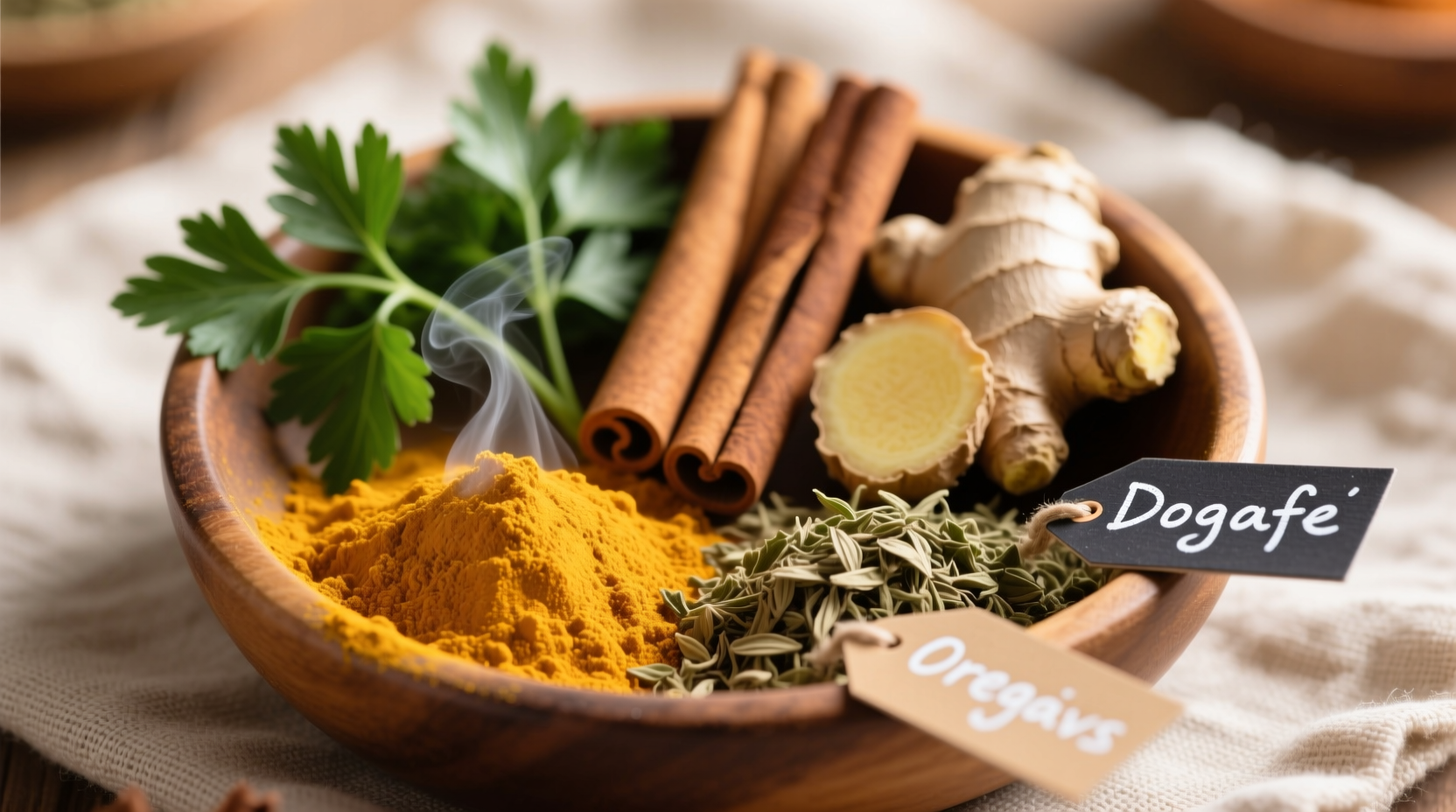When it comes to spices safe for dogs, turmeric, cinnamon, and ginger top the list of beneficial options. Turmeric offers anti-inflammatory benefits when combined with black pepper and healthy fats, cinnamon in small amounts may support blood sugar regulation, and ginger can aid digestion and reduce nausea. However, many common spices like nutmeg, garlic, and onion are toxic to dogs and should be strictly avoided. Always consult your veterinarian before introducing any new spice to your dog's diet, especially for dogs with pre-existing health conditions or those on medication.
As a dog owner, you've likely wondered whether those spices in your kitchen cabinet could benefit your furry companion. With increasing interest in natural pet care solutions, understanding which spices are safe—and which pose serious health risks—is essential knowledge. This guide provides science-backed information from veterinary sources to help you make informed decisions about incorporating spices into your dog's wellness routine.
Immediate Action Guide: What to Do If Your Dog Ingests Spices
Accidents happen—your dog might snatch food from the counter or investigate your spice collection. Knowing how to respond immediately can prevent serious health complications. Not all spices affect dogs equally, so your response should be tailored to the specific substance ingested.
| Spice Type | Immediate Risk Level | Action Required |
|---|---|---|
| Turmeric, Cinnamon, Ginger | Low | Monitor for mild digestive upset; contact vet if symptoms persist beyond 24 hours |
| Garlic, Onion, Chives | High | Contact vet immediately; these can cause hemolytic anemia |
| Nutmeg | Critical | Emergency vet visit required; can cause tremors and seizures |
| Black Pepper | Minimal | Generally safe in small amounts; monitor for digestive sensitivity |
This risk assessment aligns with guidelines from the American Kennel Club, which emphasizes that certain spices affect dogs differently than humans due to their distinct metabolism. While small amounts of some spices offer health benefits, others contain compounds that dogs cannot process effectively.
Understanding Why Spice Safety Varies for Dogs
Dogs process food differently than humans, making some seemingly harmless spices potentially dangerous. The key factor is how canine physiology handles specific compounds found in spices. For example, garlic and onions contain thiosulfate, which damages red blood cells in dogs but doesn't affect humans. This biological difference explains why foods safe for us can be toxic to our pets.
According to research published by Veterinary Partner, a service of the Veterinary Information Network, dogs lack certain enzymes that help humans metabolize specific compounds found in spices. This metabolic limitation means that substances we process without issue can accumulate to toxic levels in dogs.
Top 3 Beneficial Spices for Dogs: Science-Backed Benefits
Turmeric: The Golden Spice for Joint Health
Turmeric contains curcumin, a powerful anti-inflammatory compound that may help dogs with arthritis and joint pain. However, curcumin has low bioavailability on its own. For dogs to benefit, turmeric should be combined with black pepper (which contains piperine to enhance absorption) and a healthy fat like coconut oil.
A 2021 study in the Journal of Veterinary Pharmacology and Therapeutics found that dogs receiving a curcumin formulation showed significant improvement in mobility scores compared to the control group. The recommended dosage is 15-20 mg per pound of body weight, but always consult your veterinarian for proper dosing specific to your dog's condition.

Cinnamon: Blood Sugar Regulation Support
While cinnamon isn't essential for dogs, small amounts may offer benefits for dogs with blood sugar concerns. Research from National Center for Biotechnology Information suggests cinnamon may help regulate blood glucose levels. However, excessive amounts can cause liver issues or mouth irritation.
The safe amount is approximately 1/8 teaspoon for small dogs and up to 1/2 teaspoon for large dogs, no more than twice weekly. Always use Ceylon cinnamon rather than Cassia, which contains higher levels of coumarin that can be harmful in larger quantities.
Ginger: Natural Nausea Relief
Ginger's antiemetic properties make it valuable for dogs experiencing motion sickness or digestive upset. A study published in Alternative Therapies in Health and Medicine documented ginger's effectiveness in reducing nausea in multiple species.
For dogs, administer 1/4 teaspoon of fresh ginger juice or powder per 10 pounds of body weight. You can mix it with food or create a ginger tea by steeping fresh ginger in hot water, then cooling before adding to your dog's water bowl. Avoid giving ginger to dogs with bleeding disorders or those taking blood-thinning medications.
Spices to Avoid Completely: The Danger Zone
Certain spices pose significant health risks to dogs and should never be given intentionally. The most dangerous include:
- Nutmeg: Contains myristicin, which can cause hallucinations, increased heart rate, and seizures even in small amounts
- Garlic and Onion: Damage red blood cells leading to hemolytic anemia; symptoms may not appear for several days
- Chives: Part of the allium family like garlic and onions, with similar toxic effects
- Hot Peppers: Can cause severe digestive upset, drooling, and pawing at the mouth
The Pet Poison Helpline reports that garlic and onion toxicity accounts for approximately 17% of all spice-related pet poisonings annually. Symptoms of toxicity may include weakness, pale gums, rapid breathing, and dark urine.
Practical Application: How to Safely Introduce Spices to Your Dog's Diet
When introducing any new spice to your dog's diet, follow these evidence-based guidelines:
- Start with minimal amounts: Begin with 1/4 of the recommended dose to assess tolerance
- Monitor for 48 hours: Watch for signs of digestive upset, itching, or other adverse reactions
- Combine with food: Always mix spices with your dog's regular food to prevent stomach irritation
- Maintain consistency: If beneficial, continue with the same dosage rather than increasing
- Document effects: Keep a journal of any changes in mobility, digestion, or overall wellness
Remember that spices should complement—not replace—your dog's balanced diet. The American College of Veterinary Nutrition emphasizes that dogs have specific nutritional requirements that commercial diets are formulated to meet. Spices should be considered occasional supplements rather than dietary staples.
Veterinary Guidance: When to Consult Your Professional
Before introducing any spice to your dog's regimen, consult your veterinarian, especially if your dog has:
- Pre-existing health conditions like liver or kidney disease
- Is pregnant or nursing
- Is taking medications that might interact with spices
- Has a history of food sensitivities or allergies
Veterinarians can provide personalized guidance based on your dog's specific health profile. Many integrative veterinarians now incorporate evidence-based herbal and spice recommendations into their treatment plans, but always ensure they're aware of everything you're giving your pet.
Myth vs. Reality: Common Misconceptions About Spices and Dogs
Several myths circulate about spices and dogs that need clarification:
- Myth: All natural substances are safe for dogs
Reality: Many natural substances like garlic and xylitol are toxic to dogs - Myth: If a spice is safe for humans, it's safe for dogs
Reality: Dogs metabolize compounds differently; what's safe for us may be harmful to them - Myth: More is better when it comes to health benefits
Reality: Many beneficial compounds have narrow therapeutic windows; excess can cause harm
According to the American Veterinary Medical Association, the most common mistake pet owners make is assuming human-safe foods are automatically safe for dogs. This misconception leads to thousands of preventable veterinary visits each year.











 浙公网安备
33010002000092号
浙公网安备
33010002000092号 浙B2-20120091-4
浙B2-20120091-4